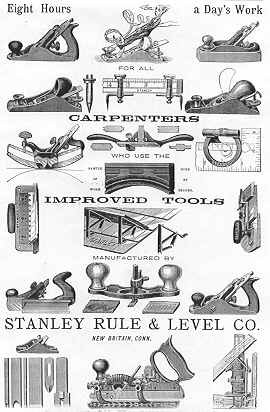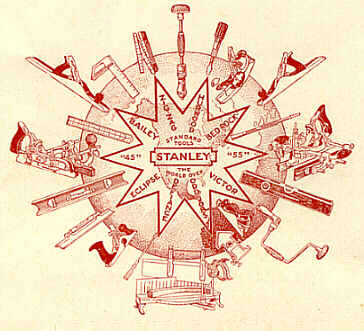The Superior Works: Patrick's Blood and Gore Beginning of the Saga
Preface.
 In a former life, before
telling The Man to KMA, I was a software dork. There, I said
it. One of the requirements of being such a dork is that you
must cruise the internet, or what the media pundits have
labelled "The Information Superhighway." I'm also a tool
fanatic. These two afflictions led me to that place where I
could converse with similar sufferers - rec.woodworking, aka
rec.norm, the news group for those computer literates who
also have a life.
In a former life, before
telling The Man to KMA, I was a software dork. There, I said
it. One of the requirements of being such a dork is that you
must cruise the internet, or what the media pundits have
labelled "The Information Superhighway." I'm also a tool
fanatic. These two afflictions led me to that place where I
could converse with similar sufferers - rec.woodworking, aka
rec.norm, the news group for those computer literates who
also have a life.
This effort was prompted by several folks asking me
about the Stanley planes that they own, or saw while out
cruising for tools. I found that many of the questions they
asked were the same ones asked over and over. For the sake
of consistency, and for the economy of my time, I decided to
do a 'brain dump' of what I know about Stanley planes - what
they look like, what they do, what common parts are missing,
what flaws they suffered during use, etc.
All of my effort was done as a lark. I never once
thought that what I was writing would ever evolve into a
'cult classic.' The first version of this effort was done in
the pre-dawn darkness while my eyes were propped open with
toothpicks; there were glaring errors of omission and
misinformation most of which I can attribute to the early
morning cobwebs that cluttered my mind. So, after having
chucked the software gig, it was either sitting in front of
the tube while watching Jerry Springer and strumming my lips
or doing something constructive. Opting for the latter, with
the donnybrooks of Springer as background noise, I embarked
upon a rewrite of Blood and Gore to make it more thorough
and accurate. It will never be a work considered done as new
information about the company and the planes that they
produced seems to surface daily.
The style of most of what I write is tongue in cheek,
but some of it very serious (like the information about the
#45 and #55). Afterall, a source of
information about the tools should include the good, the
bad, and the ugly, all of which Stanley managed to make.
The physical data of each entry was referenced from
Alvin Sellens' pioneer work, The Stanley Plane (now out of
print), and from John Walter's current book, Antique and
Collectible Stanley Tools. Both of these books
cross-reference the original tool catalogues and literature
produced by Stanley as the source for their information.
Other than that, everything that follows each listing is
from the dark corners of my mind.
 This
information is not so much offered to indicate the rarity or
collectability of each tool, even though some mention of
that is made. It's hoped that the information within will be
used as a field guide while doing the tool hunt. If it is
possible to classify Stanley planes into two groups (hey,
the legacy of being a former computer dork still makes me
see the world with a binary modus operandi), where one group
may be considered as common, and the other not so common,
then the booklet can serve a useful purpose given the
aforementioned distinction. An asterisk, represented by the
ascii character '*', found at the end of each listing
indicates that the plane falls into the not so common
category. Its value is entirely up to you.
This
information is not so much offered to indicate the rarity or
collectability of each tool, even though some mention of
that is made. It's hoped that the information within will be
used as a field guide while doing the tool hunt. If it is
possible to classify Stanley planes into two groups (hey,
the legacy of being a former computer dork still makes me
see the world with a binary modus operandi), where one group
may be considered as common, and the other not so common,
then the booklet can serve a useful purpose given the
aforementioned distinction. An asterisk, represented by the
ascii character '*', found at the end of each listing
indicates that the plane falls into the not so common
category. Its value is entirely up to you.
The booklet also ignores the cheaper brands of
Stanley planes. Remember, this originally was a guide for
those guys who intended to use what they purchased. I can't,
in good conscience, recommend that someone use a Four Square
or Handyman plane over a Bailey or a Bed Rock. In my
disturbed mind, Stanley's lesser planes were the first
trickle of oil to grease the slippery slope of the decline
of handtool quality, which now leaves us with the junk
manufactured today.
A few things to mention that will spare me some
typing - all length measurements are for the soles, and all
width measurements are for the irons. The weight of each
plane follows its measurements, which is in turn followed by
the years the plane was offered. The planes may not have
been in production for the timespan listed, which is usually
the case for the rarer planes. It was often that these
'braindead' planes were offered until they sold out the
initial production run.
Most of the planes have their number cast into them.
Those that never had their number cast into them are noted.
The "C" designation means that the plane has corrugations in
the sole; the "C" doesn't appear on the plane.
Repairs and Condition
It's inevitable that once something becomes collectable or valuable, it also gives rise to fakes, copies, and repairs. These planes are no different than that of any other field of collecting where unscrupulous, get-rich-quick, ought-to-be-making-license-plates-for-a-living, types abound.
Fortunately, the fakes are few and far between. These
are covered, in sufficient detail, in the relevant listings.
Copies are also somewhat small in number, but they are not
made to fool anyone. Other copies are those tools that were
made directly from an original tool, usually by a
patternmaker for his own use. These are rather easy to spot
since they are smaller than the originals and often have a
grainier texture to their non-machined surfaces.
Repairs are the real bane of collecting. It's been
going on for decades in other fields, and is now part of the
tool scene. If it's easy to repair, and to fool collectors
of, mechanical banks, then it's a relative picnic to do the
same with tools. Chips and missing chunks of castings are
very easy to fill using finesse welding. The welds are
colored to match their surrounding and then are machined to
be unnoticeable. These are very difficult to detect, and one
should always be suspicious of repairs to areas where the
tool is susceptible to breakage. You're on your own when
examining the tool. An honest person will point out repairs,
so know your source!
Another area of concern is the tool's finish and its
originality. There are many starving artist would-be
Picassos in this field, where taking a beat up tool and
'metamorphosizing' it into a work of art worthy of some
champagne and brie gala preview, is becoming more
commonplace. The re-machining of surfaces and the
re-japanning of painted surfaces is often used to make the
tool appear as something it's not. Usually, a close
scrutinization of the piece will reveal a slip-up by the
'artist;' a drop of paint someplace it shouldn't be, a small
area of rust found in a hard-to-reach place, a replacement
part that doesn't match the vintage of the tool, etc. As
with repairs, know your dealer. If you have any questions
about the tool you're buying, get it vetted by a third,
fourth, fifth party. It's your money you're spending,
afterall.
Categories
There are a wad of Stanley planes, many of which fit into nice categories. Blood and Gore was written in numerical sequence following Stanley's bizarre numbering system from #1 to #608C. Fortunately, some of Stanley's efforts fit into categories, and Blood and Gore treats these planes as a separate listing; e.g., the Bailey line of planes, the transitionals, the Bed Rocks, etc. In total, there are 15 major parts of Blood and Gore. You can visit them sequentially, or jump right to the part in interest simply by finding the number on the tool in question and referencing it against the hyperlinked categories listed below. Eventually, I hope to make this queryable, where you can enter a category or a plane number and get back just the listing for the tool(s). Stay tuned.
It's important to note that these files are loaded
with wads of images and will likely take time to download. I
hope you find that time well spent. If you don't, email me (leach@supertool.com) with complaints, suggestions,
questions, attaboys, tools for sale, etc. Furthermore, if
you'd like to see the author of this blather stammer,
bumble, and otherwise look like a total chump live on
videotape as he describes these Stanley planes, follow
this link to my chum Anatol's
page
for more info.
Pick a Plane, any Plane......
- Planes #1 - #8C (The much-loved and found under every rock Bailey bench planes)
- Planes #9 - #11 1/2 (mostly block planes, with the rabbet bench planes, and the now useless belting plane)
- Planes #12 - #20 1/2 (scrapers, more block planes, and circular planes)
- Planes #21 - #37 (everybody's favorite planes for keeping warm, the flammable transitional planes)
- Planes #39 - #44 (painful dados, the scrub planes, and the works of art Miller's Patents)
- Planes #45 - #A45 (the combination plane that has parts in the same realm as missing socks)
- Planes #46 - #54 (more combination planes, match planes, and the heavy-metal shooting board)
- Planes #55 - #57 (the most painful combination plane of all and the geometric marvels of plane-dom, core box planes)
- Planes #60 - #70 (more block planes - they never end - hand beaders, and the mundane box scraper)
- Planes #71 - #87 (routahs, chamfer plane, rabbet planes, and scrapers)
- Planes #90 - #100 (rabbet planes, side rabbets, special purpose planes - chisel and edge trimming)
- Planes #100 1/2 - #140 (more damn block planes, cheesy transitionals, and the best scraper ever made - #112)
- Planes #141 - #196 (match planes, rabbet planes, some funky special purpose planes, and the dreaded fiberboards)
- Planes #201 - #444 (still more block planes, weatherstripping planes, special dados, scrapers, and dovetail plane)
- Planes #602 - #608C (the over-hyped Bed Rock series)
[ START ] | [ PREV ] | [ NEXT ] | [ END
]
[ HOME
]
Copyright
(c) 1998-2012 by Patrick A. Leach. All
Rights Reserved. No part may be
reproduced by any means without the
express written permission of the
author.